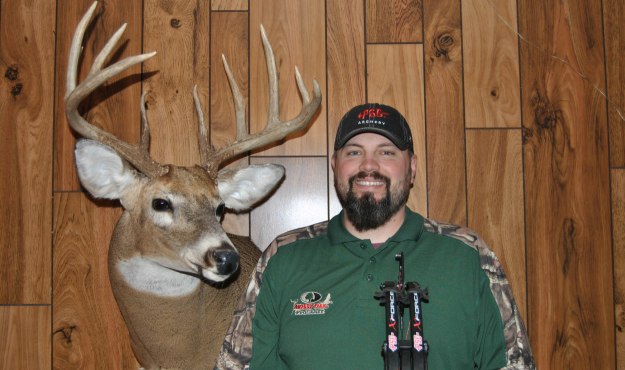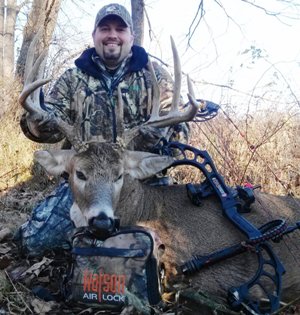
Editor’s Note: Curtis Goettsch, who lives in Cresco, Iowa, first wore military camo given to him by a friend. “I wore that army camouflage until I could save enough money to buy real camouflage,” Goettsch says. Then he purchased a Mossy Oak suit, and he's never changed his choice of camo. He joined the Mossy Oak Pro Staff in 2010 and is a nationally-recognized turkey caller and avid deer hunter. “I feel extremely fortunate to have been selected to be a Mossy Oak Pro Staffer,” Goettsch explains.
From the last week of October until the second week of November - give or take a few days on either side of these two dates - is when I'm hunting for rutting bucks in Iowa. My favorite time to hunt the rut is just before the beginning of the rut. I target my rut hunting around Halloween - the last few days of October and the first few days of November, and that’s when I'm most successful at taking mature bucks. What I like best about this time of the hunting season is seeing bucks chasing does.
I focus my hunting on travel corridors inside the timber at this time of the season. I like to set-up my tree stand 20 to 30 yards inside the timber along a fence line or an agricultural field. I focus on pinch points where the terrain forces the deer to travel through small necks of woods, between a fence line and a creek or the edge of field and a ditch. I've also learned that during the rut bucks start using trails they generally don’t use prior to the rut, or when the rut’s over. At this time of the year, they’ll be using the trails that the does and fawns normally use. So, trails will have numbers of deer moving up and down them.
 At this time of the year, food isn’t the mature buck’s primary motivation. His primary reason for moving is to find a doe. My ideal setup will be to identify a heavily-traveled deer trail close to a bedding area, because bucks will cruise and look for does downwind of a bedding spot. By walking downwind of a bedding area, the buck can smell any doe there in estrus. He also can smell any doe that’s left the bedding region and moved down a heavily-used deer trail going out of and into the bedding area. A bucks often will chase an estrous doe out of a bedding place or even may go into a bedding area and roust an estrous doe out of her bed, whether she’s with another buck or not. Once a buck picks up the smell of an estrous doe coming out of the bedding area, the buck will take off after her, even if that doe has another buck with her. The very beginning of the rut is when I believe the most bucks are out searching for does to breed. At the beginning of the rut, there's not as many bucks locked-down with does as there are one week after the rut begins. Of course, bucks still will be moving during lockdown. However after the rut begins, you won’t see as many bucks chasing does as you do the week when the rut first starts.
At this time of the year, food isn’t the mature buck’s primary motivation. His primary reason for moving is to find a doe. My ideal setup will be to identify a heavily-traveled deer trail close to a bedding area, because bucks will cruise and look for does downwind of a bedding spot. By walking downwind of a bedding area, the buck can smell any doe there in estrus. He also can smell any doe that’s left the bedding region and moved down a heavily-used deer trail going out of and into the bedding area. A bucks often will chase an estrous doe out of a bedding place or even may go into a bedding area and roust an estrous doe out of her bed, whether she’s with another buck or not. Once a buck picks up the smell of an estrous doe coming out of the bedding area, the buck will take off after her, even if that doe has another buck with her. The very beginning of the rut is when I believe the most bucks are out searching for does to breed. At the beginning of the rut, there's not as many bucks locked-down with does as there are one week after the rut begins. Of course, bucks still will be moving during lockdown. However after the rut begins, you won’t see as many bucks chasing does as you do the week when the rut first starts.
I'm often asked, “Do you use deer calls?” My answer is, “Yes.” I always have a Primos Can Call (www.primos.com) that you turn upside down, and it gives a bleat with me. Also, I always have a grunt call. If I'm not seeing any deer, especially bucks, I’ll blow the grunt call occasionally just to try and make contact with a buck. However, I believe the grunt call is the most effective for me when I can see the buck and understand what effect my call is having on the buck. When a buck is going away from me, if I can blow the grunt call one, two or three times, stop the buck and get him to turn and walk toward me, then I won’t use the grunt call again. I think using deer calls is much like using turkey calls. Once you’ve got the critter coming to you, there's no reason to call again. If you call to a deer or a turkey after it’s made the decision to come to you, I think there's a greater chance you'll stop or spook the deer or turkey and prevent it from coming to you. If the deer loses interest and starts walking away from me, I’ll blow the grunt call again. Getting the buck’s attention and getting him to look for you is the most-important thing in using a deer call, not to keep talking to him until he has your street address and the numbers on your house.
Day 3: Curtis Goettsch Tells About Early Season Deer Ice Cream – Green Browse Food Plots
Tomorrow: Curtis Goettsch on Tactics for Hunting Iowa’s Late Season Agriculture






























